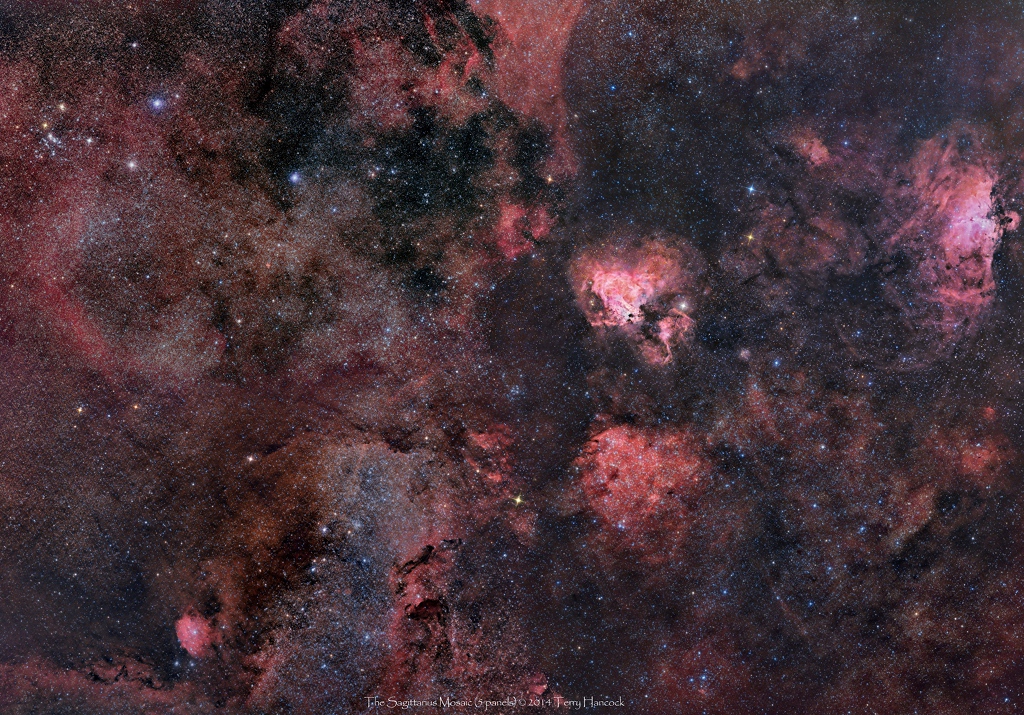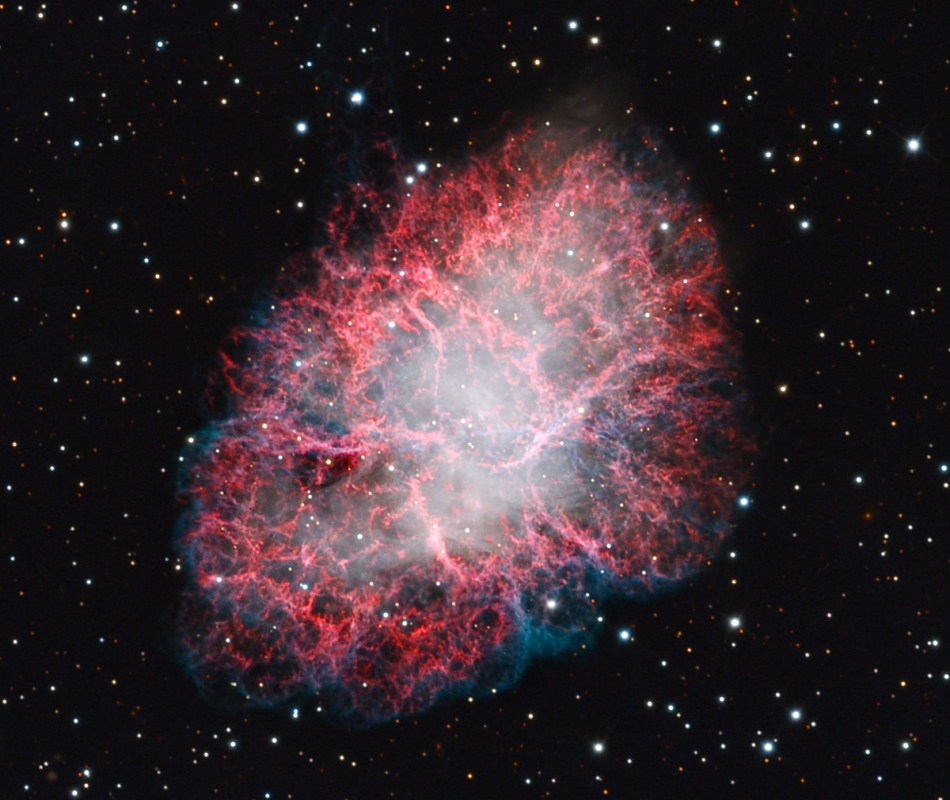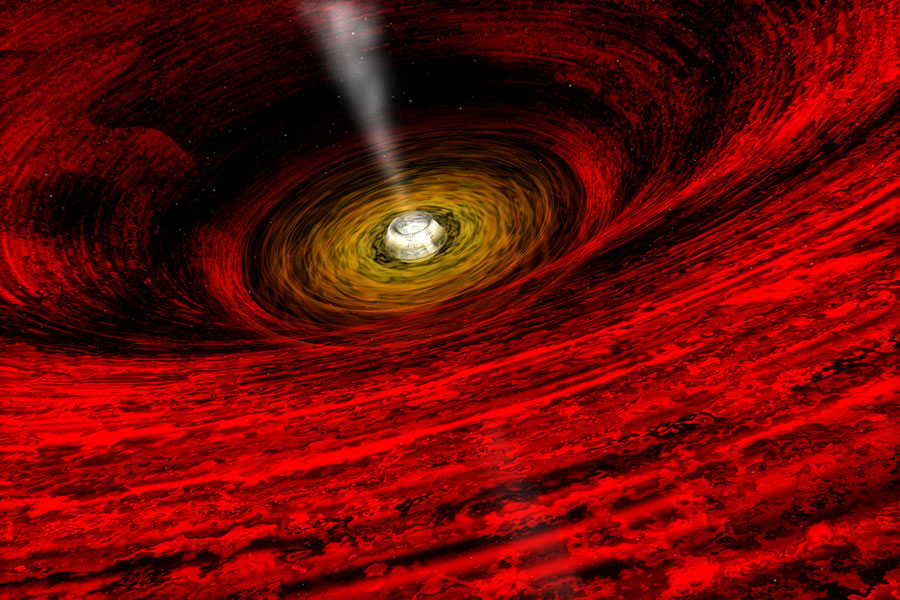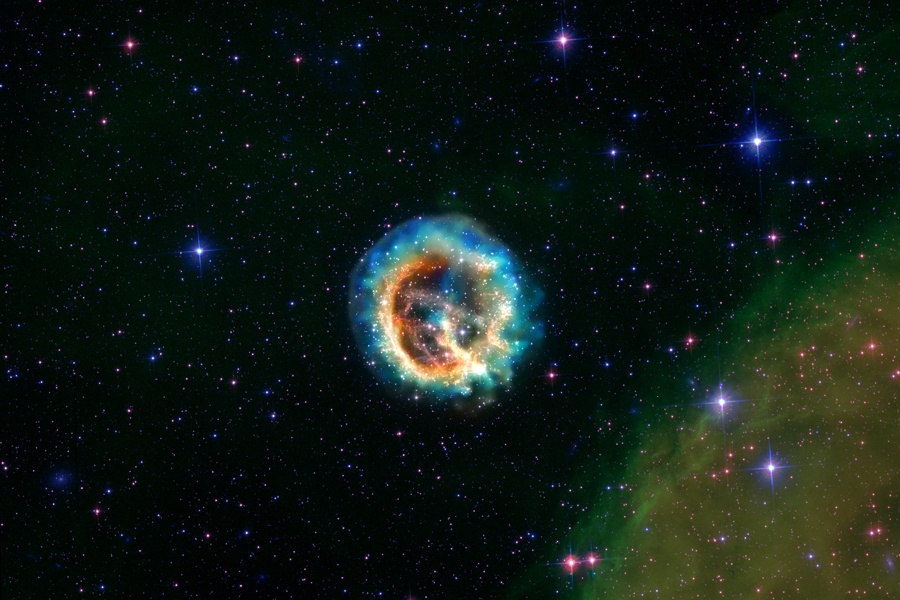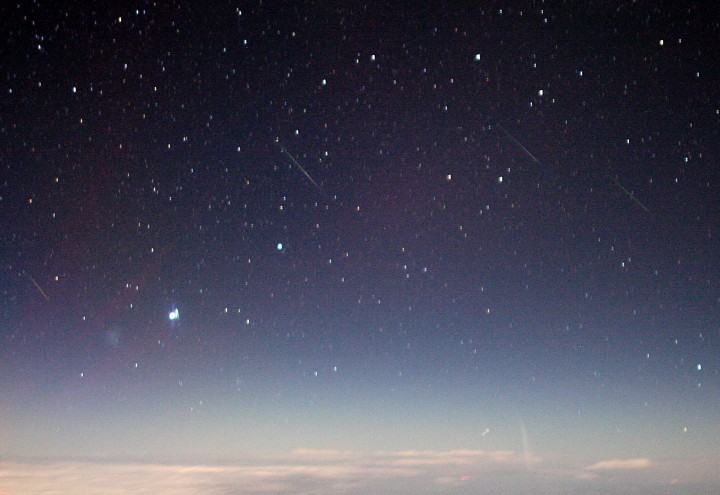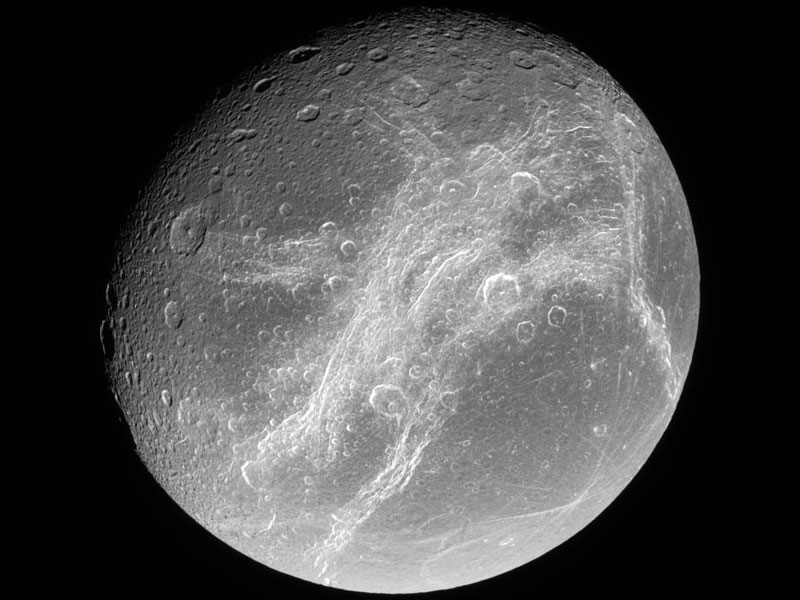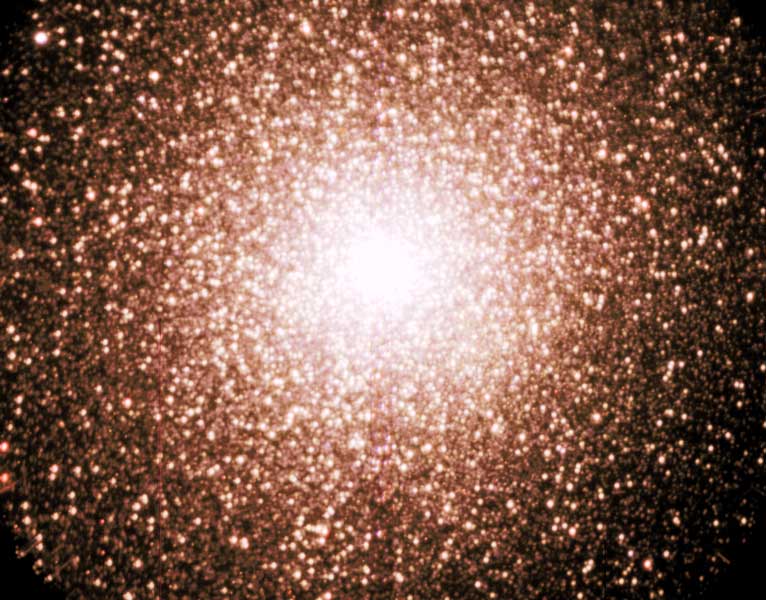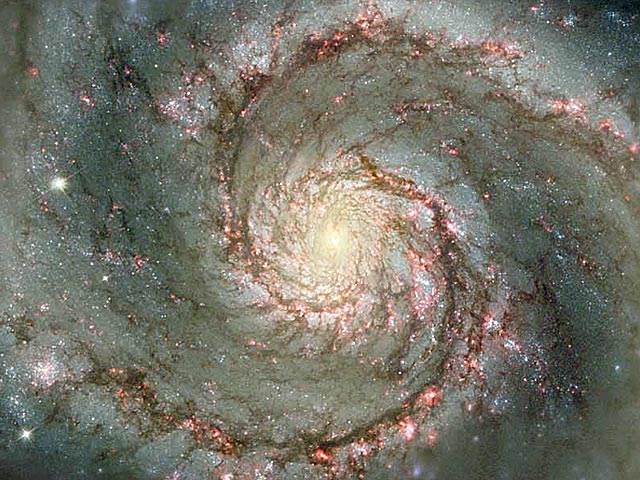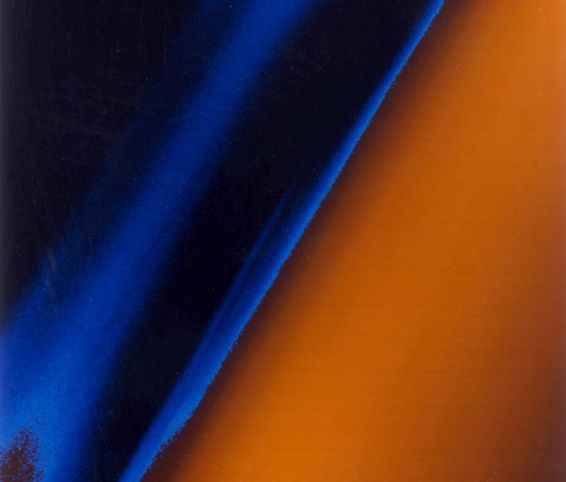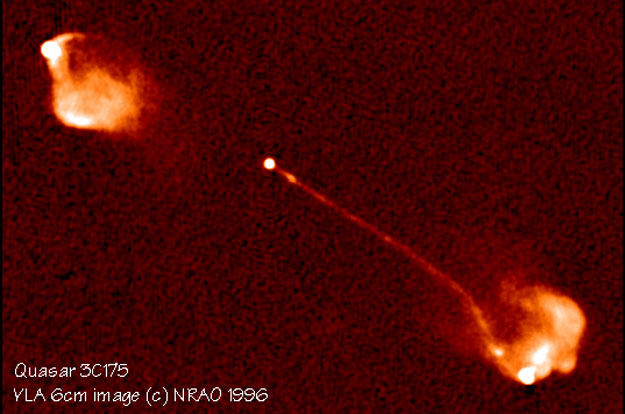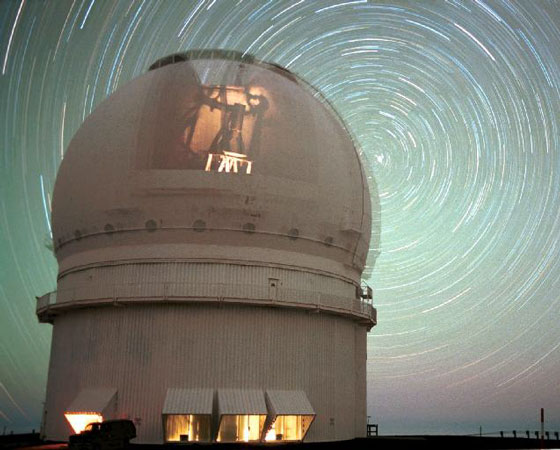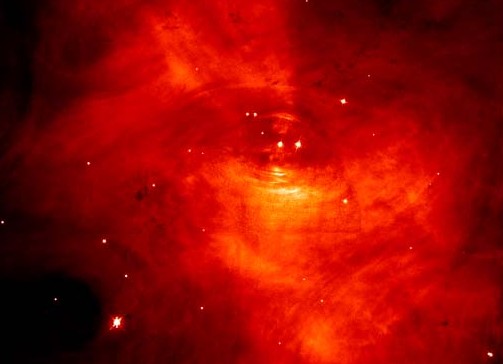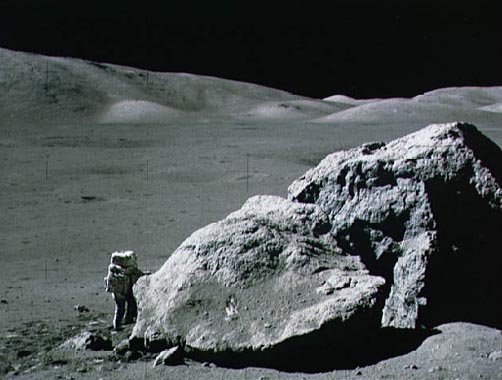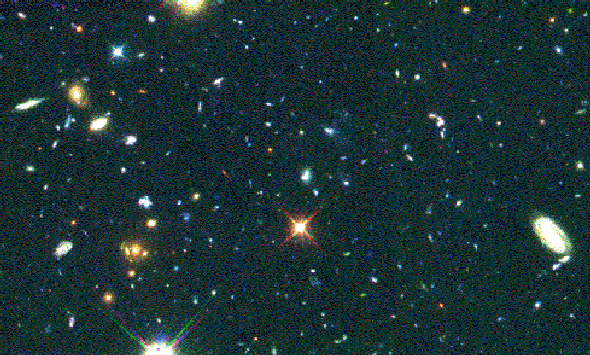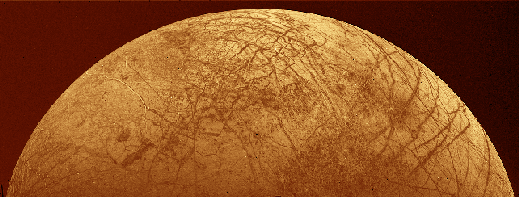| << Previous | Index | Next >> |
2015 Early morning risers along Florida's Space Coast, planet Earth, were treated to a launch spectacle on September 2nd. Before dawn an Atlas V rocket rose into still dark skies carrying a US Navy communications satellite from Cape Canaveral Air Force Station into Earth orbit. This minutes long exposure follows the rocket's arc climbing eastward over the Atlantic. As the rocket rises above Earth's shadow, its fiery trail becomes an eerie, noctilucent exhaust plume glinting in sunlight. Of course, the short, bright startrail just above the cloud bank is Venus rising, now appearing in planet Earth's skies as the brilliant morning star.
2014 This rich starscape spans nearly 7 degrees on the sky, toward the Sagittarius spiral arm and the center of our Milky Way galaxy. A telescopic mosaic, it features well-known bright nebulae and star clusters cataloged by 18th century cosmic tourist Charles Messier. Still popular stops for skygazers M16, the Eagle (far right), and M17, the Swan (near center) nebulae are the brightest star-forming emission regions. With wingspans of 100 light-years or so, they shine with the telltale reddish glow of hydrogen atoms from over 5,000 light-years away. Colorful open star cluster M25 near the upper left edge of the scene is closer, a mere 2,000 light-years distant and about 20 light-years across. M24, also known as the Sagittarius Star Cloud, crowds in just left of center along the bottom of the frame, fainter and more distant Milky Way stars seen through a narrow window in obscuring fields of interstellar dust.
2013 The Crab Nebula is cataloged as M1, the first on Charles Messier's famous list of things which are not comets. In fact, the Crab is now known to be a supernova remnant, an expanding cloud of debris from the explosion of a massive star. The violent birth of the Crab was witnessed by astronomers in the year 1054. Roughly 10 light-years across today, the nebula is still expanding at a rate of over 1,000 kilometers per second. Want to watch the Crab Nebula expand? Check out this video (vimeo) animation comparing an image of M1 taken in 1999 at the European Southern Observatory, with this one, taken in 2012 at the Mt. Lemmon Sky Center. Background stars were used to register the two images. The Crab Nebula lies about 6,500 light-years away in the constellation Taurus.
2012
[imghover6=http://apod.nasa.gov/apod/image/1209/ai ... nn_960.jpg]http://apod.nasa.gov/apod/image/1209/ai ... ed_960.jpg[/imghover6]Image Credit & Copyright: Jens Hackmann
2011
Click to play embedded YouTube video.
Image Credit: NASA, ESA, & P. Haritgan (Rice U.)
2010 In the center of a swirling whirlpool of hot gas is likely a beast that has never been seen directly: a black hole. Studies of the bright light emitted by the swirling gas frequently indicate not only that a black hole is present, but also likely attributes. The gas surrounding GRO J1655-40, for example, has been found to display an unusual flickering at a rate of 450 times a second. Given a previous mass estimate for the central object of seven times the mass of our Sun, the rate of the fast flickering can be explained by a black hole that is rotating very rapidly. What physical mechanisms actually cause the flickering -- and a slower quasi-periodic oscillation (QPO) -- in accretion disks surrounding black holes and neutron stars remains a topic of much research.
2009 The expanding debris cloud from the explosion of a massive star is captured in this multiwavelength composite, combining x-ray and optical images from the Chandra and Hubble telescopes. Identified as E0102-72, the supernova remnant lies about 190,000 light-years away in our neighboring galaxy, the Small Magellanic Cloud. A strong cosmic source of x-rays, E0102 was imaged by the Chandra X-ray Observatory shortly after its launch in 1999. In celebration of Chandra's 10th anniversary, this colorful view of E0102 and its environs was created, including additional Chandra data. An analysis of all the data indicates that the overall shape of E0102 is most likely a cylinder that is viewed end-on rather than a spherical bubble. The intriguing result implies that the massive star's explosion has produced a shape similar to what is seen in some planetary nebulae associated with lower mass stars. At the distance of the Small Magellanic Cloud, this field of view spans about 150 light-years.
2008 In search of planets and the summer Milky Way, astronomer Tunç Tezel took an evening road trip. Last Saturday, after driving the winding road up Uludag, a mountain near Bursa, Turkey, he was rewarded by this beautiful skyview to the south. Near the center, bright planet Jupiter outshines the city lights below and the stars of the constellation Sagittarius. Above the mountain peaks, an arcing cloud bank seems to lead to the Milky Way's own cloudy apparition plunging into the distant horizon. In Turkish, Uludag means Great Mountain. Uludag was known in ancient times as the Mysian Olympus.
2007 On September 1, Aurigid meteors filled the sky, in keeping with an innovative prediction of an outburst from this historically tentative meteor shower. The prediction was made by Peter Jenniskens of the SETI Institute, in work with Esko Lyytinen of Finland and Jeremie Vaubaillon of Caltech. Astronomers flying at 47,000 feet on a dedicated mission to observe the outburst collected image data for this composite photo of the Aurigids' bright and colorful streaks. The source of the shower is understood to be Comet Kiess, a comet that would have swung through the inner solar system around 2,000 years ago, and again in 1911. Pushed outward by solar radiation pressure, dust from the tail of the comet has been drifting toward the Earth's orbit, creating the 2007 outburst as well as outbursts of the Aurigids recorded in 1935, 1986, and 1994. Of course, the shower's radiant point is in the eponymous constellation Auriga, the Charioteer.
2006 What causes the bright streaks on Dione? Recent images of this unusual moon by the robot Cassini spacecraft now orbiting Saturn are helping to crack the mystery. Close inspection of Dione's trailing hemisphere, pictured above, indicates that the white wisps are composed of deep ice cliffs dropping hundreds of meters. The cliffs may indicate that Dione has undergone some sort of tectonic surface displacements in its past. The bright ice-cliffs run across some of Dione's many craters, indicating that the process that created them occurred later than the impacts that created those craters. Dione is made of mostly water ice but its relatively high density indicates that it contains much rock inside. Giovanni Cassini discovered Dione in 1684. The above image was taken at the end of July from a distance of about 263,000 kilometers. Other high resolution images of Dione were taken by the passing Voyager spacecraft in 1980.
2005 Stars come in bunches. Of the over 200 globular star clusters that orbit the center of our Milky Way Galaxy, 47 Tucanae is the second brightest globular cluster, behind Omega Centauri. Known to some affectionately as 47 Tuc or NGC 104, it is only visible from Earth's Southern Hemisphere. It was therefore a fitting target for first light observations of the gigantic new 10-meter diameter Southern African Large Telescope (SALT) this past week. The resulting image is shown above. Light takes about 20,000 years to reach us from 47 Tuc which can be seen near the Small Magellanic Cloud toward the constellation of Tucana. The dynamics of stars near the center of 47 Tuc are not well understood, particularly why there are so few binary systems there.
2004 The Whirlpool Galaxy is a classic spiral galaxy. At only 30 million light years distant and fully 60 thousand light years across, M51, also known as NGC 5194, is one of the brightest and most picturesque galaxies on the sky. The above image is a digital combination of a ground-based image from the 0.9-meter telescope at Kitt Peak National Observatory and a space-based image from the Hubble Space Telescope highlighting sharp features normally too red to be seen. Anyone with a good pair of binoculars, however, can see this Whirlpool toward the constellation of Canes Venatici. M51 is a spiral galaxy of type Sc and is the dominant member of a whole group of galaxies. Astronomers speculate that M51's spiral structure is primarily due to its gravitational interaction with a smaller galaxy just off the top of this digitally sharpened image.
2003 Streaking skyward, a Boeing Delta 2-Heavy rocket carries NASA's Space InfraRed Telescope Facility (SIRTF) aloft during the early morning hours of August 25th. The dramatic scene was recorded in a time exposure from the pier in Jetty Park at the northern end of Cocoa Beach, Florida, about 2.5 miles from the Cape Canaveral launch site. SIRTF (sounds like "sir tiff") will explore the distant Universe in infrared light as the fourth and final satellite observatory in NASA's Great Observatories Program. The three other large astrophysics satellites were designed for higher energies in the electromagnetic spectrum, with the Hubble Space Telescope operating near visible wavelengths, the Compton Gamma Ray Observatory instruments sensitive to gamma rays, and the Chandra Observatory detecting cosmic x-rays. SIRTF has been launched into an Earth-trailing solar orbit to reduce its exposure to infrared radiation from our fair planet. Cooled by an on board supply of liquid helium, SIRTF's infrared detectors will operate at near absolute zero temperatures. Presently, SIRTF's systems are undergoing a 90-day check out.
2002 Launched in 1977, 25 years ago today, the Voyager 1 spacecraft's historic tour of the outer Solar System took it past Saturn in late 1980. On November 12, 1980, Voyager 1 recorded this view looking across the edge of Titan, Saturn's largest moon, from a distance of about 22,000 kilometers. Seen in false color, the moon's hazy atmosphere appears orange with further layers of blue haze suspended above. Titan's mostly nitrogen atmosphere, denser than planet Earth's, also contains methane and is thought to be laced with more complex hydrogen and carbon compounds. The composition is likened to Earth's atmosphere before life began. Spotted by Voyager, the detached layers of haze hundreds of kilometers above the surface, along with details of Titan's atmospheric chemistry, have intrigued earth-bound researchers who have recently proposed a model that links seasonal variations in the haze, winds, and sunlight. Their model accounts for the early Voyager observations as well as subsequent studies. Further tests of the model are anticipated when the Huygens probe, carried by the saturn-bound Cassini spacecraft, enters Titan's atmosphere in 2005.
2001 3C175 is not only a quasar, it is a galaxy-fueled particle cannon. Visible as the central dot is quasar 3C175, the active center of a galaxy so distant that the light we see from it was emitted when the Earth was just forming. The above image was recorded in radio waves by an array of house-sized telescopes called the Very Large Array (VLA). Shooting out from 3C175 is a thin jet of protons and electrons traveling near the speed of light that is over one million light-years long. The jet acts like a particle cannon and bores through gas cloud in its path. How this jet forms and why it is so narrow remain topics of current research.
2000 High atop a dormant volcano in Hawaii, an eye 3.6-meters wide stares at a faint light on the night sky. Unlike a human eye, which collects light for only a fraction of a second at a time, a telescope such as the Canada-France-Hawaii Telescope (CFHT) can collect light for hours. Faint sources become visible that were previously beyond human imagination. These meticulous observations usually take so long, though, that the Earth's spin causes the telescope to move under the sky. This spin is visible in the above photograph as star trails in the background. The CFHT itself must counter-spin to keep on target. The enormous size of the CFHT dome can be gauged by the car in the foreground. The CFHT is one of the smaller telescopes atop Mauna Kea.
1999 Scroll right and watch the universe evolve. Above is a computer simulation depicting the evolution of our entire universe. On the far left is a slice of the universe soon after the Big Bang - over 10 billion years ago. As time progresses toward the right, the initially smooth universe can be seen becoming more and more clumpy. The vertex near the far right marks the present day. The largest slice of the universe actually surveyed is simulated to the vertex's right. This artificial universe, called a Hubble Volume, was designed to mimic what humanity might see were we to have powerful enough telescopes. By comparing different computer simulations to reality, we might be able to better tell what kind of universe we live in.
1998 In the Summer of 1054 A.D. Chinese astronomers reported that a star in the constellation of Taurus suddenly became as bright as the full Moon. Fading slowly, it remained visible for over a year. It is now understood that a spectacular supernova explosion - the detonation of a massive star whose remains are now visible as the Crab Nebula- was responsible for the apparition. The core of the star collapsed to form a rotating neutron star or pulsar, one of the most exotic objects known to 20th century astronomy. Like a cosmic lighthouse, the rotating Crab pulsar generates beams of radio, visible, x-ray and gamma-ray energy which, as the name suggests, produce pulses as they sweep across our view. Using a stunning series of visible light images taken with the Hubble Space Telescope (HST), astronomers have discovered spectacular pulsar powered motions within the Crab nebula. Highlights of this HST Crab "movie" show wisps of material moving away from the pulsar at half the speed of light, a scintillating halo, and an intense knot of emission dancing, sprite-like, above the pulsar's pole. Only 6 miles wide but more massive than the sun, the pulsar's energy drives the dynamics and emission of the nebula itself which is more than 10 lightyears across. In this HST image, the pulsar is the left most of the two bright central stars.
1997 Twenty five years ago humans roamed the Moon. Pictured here during the last moon landing, scientist-astronaut Harrison Schmitt was photographed standing next to a huge, split boulder. Apollo 17 was one of six missions that landed humans on the moon and returned them safely. Apollo 17 explored the unusually dark terrain at the Taurus-Littrow landing site, deployed explosives to test the internal geology of the Moon, and returned the most rocks of any lunar mission.
1996 Snips and snails and puppy dog tails, is that what galaxies were made of? In a report released yesterday and soon to be published in Nature, astronomers have imaged an interesting distant patch of sky with the orbiting Hubble Space Telescope. They found many merging groups of stars and gas which have been dubbed "pre-galactic blobs." A particularly dense bunch of these small blue merging objects are visible in the above picture. This may be a snapshot of galaxies actually being formed! Although peculiar by present standards of galaxies, these blobs may have been normal in the distant past, many billions of years ago. This adds evidence that galaxies formed from the conglomeration of smaller objects instead of the fragmentation of larger objects.
1995 Beneath the cold icy surface of Jupiter's moon Europa are probably the only oceans of water in our Solar System outside of Earth. These oceans, possibly 50 kilometers deep, might also be the most likely local place to find extra-terrestrial life. Europa's smooth surface is unlike any other known planet or moon, giving evidence for relatively few craters or mountains. Europa was discovered by Galileo and Marius in 1610. The NASA spacecraft Galileo is scheduled to arrive at Jupiter in December of 1995.
| << Previous | Index | Next >> |

